|
Topics to be Learn :
- Introduction
- Criteria Used for Animal Classification
- Animal Body Plan
- Animal Classification
|
Basis for classification : Grades of organization, body symmetry, body cavity, germ layers and segmentation, form the basis for classification.
Robert Whittaker proposed the five kingdom system of classification.
Need and importance for classification :
Need and importance for classification:
- Classification facilitates the identification of animals with great accuracy.
- The study of animals becomes convenient.
- It helps in understanding the relationship of animals with other living organisms.
- It helps to understand the habitat of each animal along with its role in nature.
- By studying few animals from a group, we can gain a better understanding about the entire group.
- It helps in understanding different adaptations shown by animals. ,
- It gives an idea about evolution of animals.
[collapse]
Criteria used for animal classification:
Grades of organization in animals : Cellular, cell- tissue, tissue-organ are the grades of organization in animals.
- Cellular Level : It is the arrangement of cells in the form of loose cell aggregates.
- Some division of labour occurs among cells.
- No nervous co-ordination.
- g. Porifera
- Tissue Level : Cells performing same function are arranged in the form of tissues. e.g. Coelenterates
- Organ Level : Tissues are grouped together to form organs. Each organ is specialised for a particular function. e.g. Platyhelminthes
- Organ System : Organs are associated to form functional systems, each concerned with a specific physiological function.
- In different groups of animals, organ systems exhibit various patterns of complexities. e.g. Aschelminthes, Annelids, Arthropods, Molluscs, Echinoderms and Chordates.
- Body cavity : The animals are classified as acoelomates, pseudocoelomates, and coelomates based on body cavity.
Body symmetry : The animals are classified as Asymmetry, Radial Symmetry, and Bilateral Symmetry.
Body symmetry implies to the similarity in shape, size and number of parts on the opposite sides of a median line when body is divided into two halves by an imaginary line along different plane. Animals may be asymmetrical, radially symmetrical or bilaterally symmetrical.

- Asymmetrical-animals: An animal is said to be asymmetrical when its body cannot be divided into two identical halves in any plane
- Radially symmetrical animals: In certain animals, body can be cut or divided into two similar halves in a number of planes wherein, all the cuts (planes) pass through the centre. This type of symmetry is called radial symmetry.
- Bilaterally symmetrical animals: In this type, the body of the animal can be bisected or divided in two equal or identical halves by a single median or vertical plane.
Animal body plan :
Animals show three fundamental body plans as follows:
- Cell aggregate body plan.
- Blind sac body plan.
- Tube within tube body plan
Cell aggregate body plan:
- In this body plan, cells do not form tissues or organs
- Differentiation and division of labour among the cells is minimal.
- Members of phylum Porifera show cell aggregate body plan.

Blind sac body plan:
- In this body plan, the body is sac-like with a single opening. Digestion is carried out in this sac-like structure.
- The food is ingested and egested through the same opening.
- Members of phylum Cnidaria show a blind sac body plan.
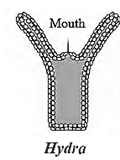
Tube within tube body plan:
- Digestive system is present in tube-like body cavity.
- Mouth and anus are present at two separate ends of the digestive system.
- Phylum Annelida onwards all phyla show tube within tube body plan.
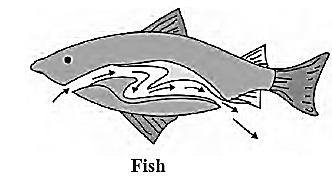
Germ layers:
- When an organism shows only two germ layers, they are called diploblastic animals. In this case, the outer ectoderm is separated from the inner endoderm by a non-living substance called mesoglea.
- When an organism shows three germinal layers, they are called triploblastic animals. The three layers are namely — outer ectoderm, middle mesoderm and inner endoderm.

Phylum Porifera (Pori = Pores: feron = bearing): Members of the phylum Porifera are also called sponges.
Characteristics of phylum Porifera :
Characteristic features of the phylum Porifera :
- Habitat: They are aquatic, mostly marine but few species are found in fresh water.
- Forms: They are sedentary animals (attached to substratum or rock).
- Body shape: They have asymmetrical body. Body of these animals consists of many cells with minimal division of labour among cells. Hence their body is considered as a colony of different types of cells.
- Body surface: Their body bears minute pores called ‘ostia’ through which water enters the spongocoel (body cavity). Water leaves the body through a large opening called ‘osculum’. Beating of flagella creates water current.
- Circulation: Water is circulated in the body through the ‘canal system’. When the water enters the body of poriferans, cells absorb the food, exchange respiratory gases and release excretory products.
- Digestive system: The body cavity of sponges is lined by unique type of flagellated cells called choanocytes or collar cells for digestion.
- Endoskeleton: The body of sponges consists of calcareous / siliceous spicules or proteinaceous ‘spongin fibres’.
- Reproduction: Sponges reproduce asexually as well as sexually. Asexual reproduction takes place by fragmentation and gemmule formation. Sexual reproduction is by formation of gamets. Fertilization is internal and development is indirect through larval stage.
- Sponges have great power of regeneration.
- E,g. Scypha, Euspongia (Bath sponge), Euplectella (Venus’ flower basket).

[collapse]
- Sponges are most primitive multicellular animals
- Digestion is intracellular.
- They are hermaphrodites.
Larval stages of Porifera:
- Parenchymula - Flagellate larvae of calclnean sponges
- Amphiblastula - Free swimming larval stage of Sycon and man){ other calcareous sponges
|
Phylum Cnidaria :
Characteristics of phylum Cnidaria :
Characteristics of phylum Cnidaria:
- Habitat: They are aquatic, mostly marine and few of them are fresh water forms.
- Forms: They are sessile or free swimming.
- Cnidoblasts: Presence of cnidoblasts or stinging cells are present on the tentacles for anchorage, offence and defence.
- Body Symmetry: They have radially symmetrical body.
- Germ layer: They are diploblastic.
- Body cavity: Cnidarians have a central cavity called coelenteron or gastrovascular cavity, which helps in digestion and circulation They have blind body—sac plan i.e., single pore opening to the exterior in the digestive system.
- Body form: Members of this phylum exhibit two body forms. The cylindrical form, known as polyp e.g. Hydra and the umbrella - like form (Aurelia - jelly fish) is known as medusa.
- Digestion: They have extracellular and intracellular digestion.
- Reproduction: Cnidarians reproduce asexually and sexually. Asexual reproduction takes place by budding and regeneration. Sexual reproduction takes place gamete formation. They exhibit metagenesis i.e. alternation of polypoid generation with medusoid generation. Polyps produce medusae asexually and medusae produce polyps sexually. e.g. Obelia,
- Examples : Hydra, Aurelia (Jellyfish), Physalia (Portuguese man-of-war), Adamsia (Sea anemone), Diploria (Brain coral), Gorgonia (sea fan).

[collapse]
Coral reefs:- Belongs to phylum Cnidaria
- A coral reef is an underwater ecosystem characterized by reef building corals.
- Coral reefs constitute 25% of all marine species on the planet.
- They belong to phylum Cnidaria.
- There are three main types of coral reefs — fringing, barrier and atoll. Coral reefs provide ecosystem services for tourism, fisheries and shoreline protection. .
- They cannot survive in high temperatures, thus due to climate change there is a sharp decline in their population.
Sea fan or Gorgonia: Belongs to phylum Cnidaria
- It is a soft coral composed of numerous polyps - cylindrical, sessile (attached) forms that grow together in a flat, fan-like pattern.
- It does not produce calcium carbonate skeletons.
Phylum Ctenophora :
The members of this phylum are commonly known as comb jellies and sea walnuts. They are also known as acnidarians as they lack cnidoblasts. The phylum is considered as one of the minor phyla as it is represented by very few members.
Features of phylum Ctenophora :
Salient features of phylum Ctenophora :
- Habitat: They are exclusively marine.
- Forms: They are free swimming animals.
- Germ layers: Members of this phylum are diploblastic.
- Body Symmetry: They are radially symmetrical.
- Body plan: The animals of this phylum show blind-sac body plan.
- Body organization: They show tissue level organization.
- Locomotion: It is carried out by eight rows of ciliated comb plates.
- Bioluminescencee: It is the characteristic feature of the members of this phylum.
- Digestion: It is extracellular and intracellular.
- Reproduction: Reproduction is sexual with indirect development.
- Colloblasts: These sticky cells are used to capture prey.
- Examples : Pleurobrachia, Crenoplana.
[collapse]
| Bioluminescence is light produced by a chemical reaction in a living organism.
Various marine organisms like fishes, bacteria, ctenophores and jellyfish exhibit bioluminescence.
Fireflies belonging to phyhun Arthropoda also exhibit bioluminescence.
The chemical luciferin and luciferase or photoprotein are involved in producing bioluminescence.
Bioluminescence is used by living organisms as defense against predators, finding mates, hunt prey and other vital activities.
|
Phylum Platyhelminthes : The members of this phylum are called as flatworms.
Features of phylum Platyhelminthes :
Features of phylum Platyhelminthes:
- Body shape: Body of these animals is dorsoventrally flattened
- Coelom : They are acoelomates.
- Germ layers: Platyhelminthes are triploblastic.
- Body organization: They show organ-system grade of organization.
- Forms: Most of them are endoparasites and few are free-living. Parasitic forms have hooks and suckers for attachment to the hosts’ body. In parasitici forms, body is covered by cuticle and in free-living forms it is covered by cilia.
- Digestive system: Parasitic fonns generally lack digestive system. In free-living forms, the digestive system is incomplete.
- Body plan: They show blind-sac body plan.
- Excretion and osmoregulation: It occurs by flame cells or protonephridia.
- Reproduction: They are mostly hermaphrodite (bisexual). Self-fertilization is seen. Few animals show high power of regeneration and show polyembryony. (Polyembryony is the condition of development of two or more embryos from a single fertilized egg. The phenomenon is common in many plant and animal species.)
- Examples: Planaria, Taenia (Tapewomi), Fasciola (Liver fluke) are included in this phylum.

- Platyhehninthes are parasitic in humans. Some platyhelminthes absorb nutrients from the host directly through their body surface.
- Planaria possess high regeneration capacity.
[collapse]
Liver fluke: Parasitic adaptations in Liver fluke
- Presence of hooks and suckers
- Body covered with cuticle
- Lacks digestive system
- They are hermaphrodites
Phylum Aschelminthes (ascus - sac, helminth - worm) is also called as Nemathelminthes (Nema = thread, helmins = worms).
Characteristics of Aschelminthes :
Characteristics of Aschelminthes:
- Forms: These are mostly parasitic. However, few forms are free-living. Example of free living platyhelminlh- Planaria
- Body shape: The body is long, cylindrical, thread-like, circular in cross section, hence they are known as roundworms.
- Body symmetry: These are bilaterally symmetrical.
- Coelom: They are pseudocoelomate animals.
- Germ layers: These animals are triploblastic.
- Body plan: They show tube within a tube type body plan.
- Body covering: The body is covered by tough, resistant cuticle.
- Muscles: Body wall has longitudinal muscles, but circular muscles are absent.
- Digestive system: Alimentary canal is complete with mouth and anus, at opposite ends.
- Excretion: Excretion takes place either by canals or gland cells.
- Nervous system: Nervous system consists of a nerve ring and nerves. » »
- Reproduction: Animals are unisexual i.e sexes are separate. Fertilization is internal. Development may or may not include larval stages. It shows sexual dimorphism.
- Examples : Ascaris (Roundworm), Wuchereria (filarial worm) and Ancylostoma (hookworm).
- Some forms of aschelminthes are aquatic and terrestrial.
- Members of phylum Aschelminthes have organ system level of body organization
[collapse]
Ascaris :
- Body long, cylindrical and thread-like
- Body covered by tough, thick and resistant cuticle
- Animals like Ascaris show sexual dimorphism.

- The male Ascaris is shorter and narrower than the female and has a curved posterior end with a pair of penial setae for copulation.
- The female Ascaris is relatively longer and broader and has a straight posterior end without penial setae.
Phylum Annelida : Annelids are commonly called as ring worms or segmented worms.
Characteristics of Annelida :
Characteristic feature of phylum Annelida:
- Forms: Annelids may be aquatic, ectoparasitic or free - living or burrowing in moist soil.
- Body symmetry: They are bilaterally symmetrical.
- Body coelom: They are true coelomates.
- Segmentation: Body is metamerically segmented and has a special region called clitellum.
- Digestive system: Alimentary canal is complete.
- Locomotion: Locomotion takes place with the help of setae (earthworm), parapodia (Nereis) or suckers (leech). Well-developed longitudinal and circular muscles help in locomotion.
- Nervous system: It consists of nerve ring and ventral solid and ganglionated nerve cord.
- Reproduction: Mostly are hermaphrodites and few are dioecious (Nereis).
- Respiration: Exchange of gases takes place through body wall.
- Circulation: Circulatory system is of closed type. Excretion and osmoregulation is carried out with help of nephridia.
- Examples : Nereis (Aquatic annelid), Pheretima (Earthworm), Hirudinaria (Leech).
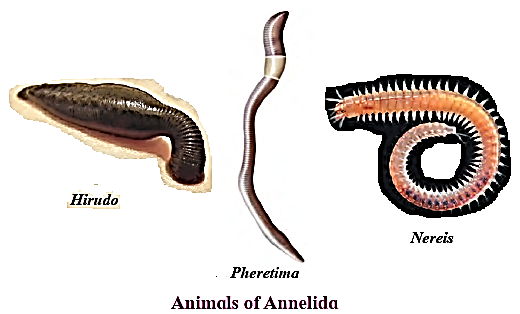
Phylum Annelida onwards all phyla show tube within tube body plan.
From Phylum Annelida onwards, all animals are triploblastic, coelomate and with organ system level of organization.
[collapse]
Merits and demerits of hermaphroditism :
Hermaphroditism is the condition in which an organism possesses reproductive organs of both the sexes.
Merits of hermaphroditism:
- Assured fertilization which reduces the risk of a species to become extinct due to unavailability of mating partner.
- Energy required for searching out mating partner is conserved.
- Frequency of mating is maximized.
Demerits of hermaphroditism :
- More energy is required to maintain both the reproductive systems.
- Limited gene diversity.
Q. Why are leeches used in Ayurveda?
Answer :
- Leeches are used in blood purification therapy to treat many diseases as they suck impure blood from the affected site of the patient’s body.
- The anticoagulant - hirudin present in saliva of leech, inhibits the coagulation of blood and makes blood thinner. This allows free blood to flow through the vessels and dissolve the clots found in vessels.
[collapse]
Q. What is the role of earthworms in agriculture? What is vermicompost?
Answer :
Role of earthworms in agriculture:
- Earthworms loosen the soil by burrowing deep into it, thus they help to aerate the soil.
- This continuous digging of soil also helps the water to reach the roots quickly.
- Earthworms can decompose the organic matter from the soil and convert it into rich manure.
- This helps in increasing the fertility of soil which ultimately increases the crop production.
[collapse]
Q. What is a vermicompost :
Answer :
Vermicompost is the product of vermicomposting. It is an organic manure produced as vermicast by earthworm feeding on biological waste material and plant residues.
[collapse]
Q. Explain the term metameric segmentation.
Answer :
In some animals, body consists of many segments arranged along the length of the body. When the external segmentation coincides with the internal segmentation, it is called as metameric segmentation and the phenomenon is called metamerism.
[collapse]
Phylum Arthropoda :
Arthropoda (Arthros: Joint, Podos: leg): Arthropoda forms the largest phylum of kingdom Animalia.
Characteristics of Arthropoda :
Characteristics of Arthropoda:
- Habitat: Arthropods are omnipresent.
- Forms: Solitary or colonial, most of them are free-living. Barnacles are sedentary. Few are parasitic and sanguivorous. (e.g. Female mosquito, bed bug.)
- Body symmetry: Body is bilaterally symmetrical.
- Germ layers: They are triploblastic.
- Body cavity: Arthropods are eucoelomates.
- Body plan: They show tube within tube body plan. . »
- Level of body organization: They show organ system level of organization.
- Special features: The members of this phylum have jointed appendages. Hence, they are known as arthropods. Some insects like honey bee, ants, termites, etc. exhibit polymorphism.
- Exoskeleton: Body is covered by a tough, non - living chitinous exoskeleton. As the exoskeleton does not allow body growth, arthropods shed off their exoskeleton periodically during growth. This process is called moulting or ecdysis.
- Body division: Body is divided into head, thorax and abdomen.
- Segmentation: Body shows metameric segmentation.
- Digestion: Digestive system is complete and divided into foregut, miidgut and hindgut.
- Circulation: Circulatory system is of open type wherein, blood flows through body cavity called haemocoel
- Respiration: Respiration occurs through respiratory organs like gills, trachea, book lungs or book gills.
- Excretion: Excretion takes place by green glands, Malpighian tubules or coxal glands.
- Nervous system: Nervous system consists of nerve ring and double, ventral ganglionated nerve cord.
- Sense organs: Arthropods have well developed sense organs in the fonn of antennae, simple of compound eye and various receptors.
- Sexual reproduction: Sexes are generally separate in arthropods with distinct sexual dimorphism.
- Animals are mostly oviparous (exception: Scorpion).
- Fertilization is generally internal. Development is direct or indirect by metamorphosis.
- In some arthropods like honey bees, bugs, etc., the offspring are produced by parthenogenesis.

[collapse]
Useful & Harmful arthropods :
Beneficial arthropods: Some arthropods are of economic importance. For example, Honey bees (Apis) are important for their honey and wax, silk worms for the production of silk. Lobsters prawns, crabs are edible.
Harmful arthropods : Some arthropods are harmful and act as vectors to spread various diseases.
e.g., Mosquitoes. Locusta (locust) is a gregarious pest. Limulus (King crab)_ is a living fossil. Other examples: Cockroach (Periplaneta) (Archispirostreptus) prawn, butterfly, scorpion (Hottentotta) and millipede.
Phylmn Arthropoda is considered as most successful phylum because of the following reasons:
- Phylum Aithropoda is the largest phylum of kingdom Animalia. It includes various forms like lobsters, prawns, crabs, insects, millipedes, locust, honeybees, etc.
- They are omnipresent .(present everywhere). Arthropods show great variety of adaptations as their habitat varies from terrestrial to aquatic habitat.
- The exoskeleton of arthropods is made up of tough chitinous exoskeleton. This enables them to survive on lands in almost all environment and is a great defense against predators.
- They possess jointed appendages which allow complex movements.
- They exhibit moulting or ecdysis.
- They have metamerically segmented body helping in movement around diverse environments.
What will happen if arthropods do not moult?
Answer :
- Moulting or ecdysis is a periodic shedding of the outer cuticle layer of body in arthropods
- The outer layer of body of arthropods is formed of tough,‘ non-living chitinous substance.
- If arthropods do not moult, they cannot grow and mature into adult forms.
[collapse]
Phylum Mollusca :
Mollusca (Mollis: Soft) is the second largest phylum.
Features of phylum Mollusca :
Features of phylum Mollusca:
- Habitat: They are aquatic or seen in marshy places. Few of them are terrestrial.
- Forms: Molluscs are either free-living or sedentary.
- Body plan: These are soft bodied and show tube within a tube type of body plan.
- Body symmetry: Most of the Molluscs show bilateral symmetry but few are asymmetrical due to torsion (twisting). .
- Body division: Body consists of head, foot and visceral mass. Visceral mass is enclosed in thick, muscular fold of body wall called mantle. Mantle secretes a hard calcareous shell that may be external or internal or absent. Muscular foot is present ventrally. '
- Digestive system: Digestive system is well-developed and complete with anterior mouth and posterior anus. Buccal cavity has a rasping organ called radula (helps in feeding), which is provided with transverse rows of teeth.
- Respiration: In aquatic forms, numerous feather-like gills called ctenidia, help in aquatic respiration. Terrestrial forms may show the presence of lungs.
- Circulatory system: Circulatory system is of open type (except in Sepia, where it is of the closed type). Blood contains a copper containing blue coloured respiratory pigment called haemocyanin.
- Excretion: Excretion occurs by kidney like structures, also called ‘Organ of Bojanus’.
- Nervous system and Sense organs: Nervous system has three pairs of ganglia. All these ganglia are interconnected by commissures and connectives.
- Sense organs: Sense organs such as eyes or vision tentacles for tactile sensation and osphradia for testing purity of water is present.
- Sexual reproduction: Sexes are usually separate. Animals of this phylum are mostly oviparous and the development is direct or indirect.
- Examples: Pila, Spisula (Bivalve), Octopus (devil fish), Sepia (cuttle fish), Chaetopleura (Chiton), Pinctada (Pearl oyster), Loligo (Squid), Aplysia (Sea hare), Dentalium (Tusk shell).
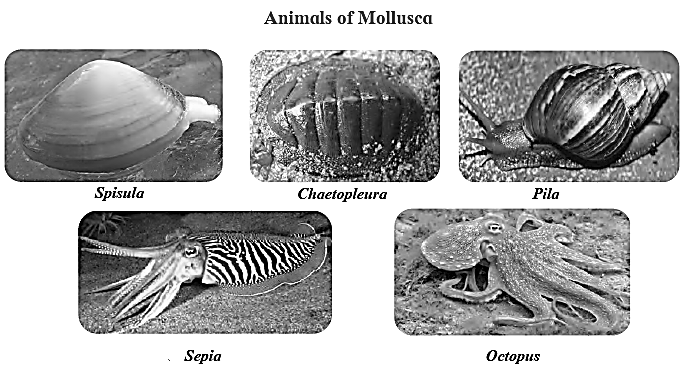
[collapse]
- Molluscs are soft bodied animals. Thus, the calcareous shell provides supports and protects the organisms from predators.
- Molluscs have mantle cavity in which feather like gills are present. It is formed due to space between the hump and the mantle.
- Body of molluscs is unsegmented
|
Economic importance of molluscs:
- Pearl oyster (Pinctada) gives precious pearls.
- Many molluscs are edible.
- Molluscan shells are rich source of calcium.
Phylum Echinodermata :
Features of phylum Echinodermata :
Features of phylum Echinodermata : (Echinus — spines, derma - skin)
- Habitat: These are exclusively marine.
- Forms: Members of this phylum are solitary, sedentary or free-living and gregarious, benthic.
- Body symmetry: These animals are radially symmetrical with pentamerous symmetry. Adult echinoderms are radially symmetrical but larval forms are bilaterally symmetrical.
- Shape: Members of Echinodermata are spherical, elongated or star - shaped.
- Body: The endoskeleton is made up of calcareous ossicles. Spines are formed on the body. Hence they are known as echinoderms. The body has two sides oral and aboral and lacks definite divisions. Mouth is ventrally present on oral surface and anus on aboral surface.
- Water vascular system: Presence of water vascular system is the peculiar character of echinoderms. Madreporite is the opening of water vascular system through which water enters. Water vascular system is useful in locomotion, food capturing, and respiration.
- Digestion: Digestive system is complete.
- Respiration: Peristomial gills, papillae, respiratory tree, etc. are used for respiration.
- Circulatory and excretory systems: Absent in echinoderms.
- Nervous system: Nervous system is simple with a nerve ring around the mouth and radial nerves in arms.
- Reproduction and development: Sexes are separate (sometimes bisexual). Fertilization is external. Development is indirect, i.e. through larval stages. They show high power of regeneration. Larvae of echinoderms are free - swimming.
- Examples : Asterias (Sea star), Cucumaria (Sea cucumber), Echinus (Sea urchin), Antedon (sea lily), Ophiothrix (Brittle star).

[collapse]
Phylum Hemichordata : (Hemi : Half, Chordata : Rod)
Features of Hemichrodata :
Characteristics of phylum Hemichordata:
- Habitat: Hemichordates are exclusively marine animals, usually living at the bottom of the sea in burrows. These are mostly free - living but animals like Rhabdopleura are sedentary.
- Body shape and division: Body is soft and vermifonn. It is unsegmented and divided into three parts namely - proboscis, collar and trunk.
- Digestive system: Alimentary canal is complete, straight or ‘U’ shaped. Buccal cavity gives rise to a rod-like buccal diverticulum.
- Respiration: Respiration is brought about by numerous gills arranged in two longitudinal rows present in the pharyngeal region. Gills open by gill slits.
- Circulation: Circulatory system is simple and open type.
- Excretion: It takes place with help of with the glomerulus.
- Nervous system: Nervous tissue is embedded in epidermis on the dorsal as well as the ventral side.
- Reproduction and development: Sexes are separate (sometimes bisexual). Fertilization is external and development is indirect through free swimming larva.
- Examples : Balanoglossus, Saccoglossus
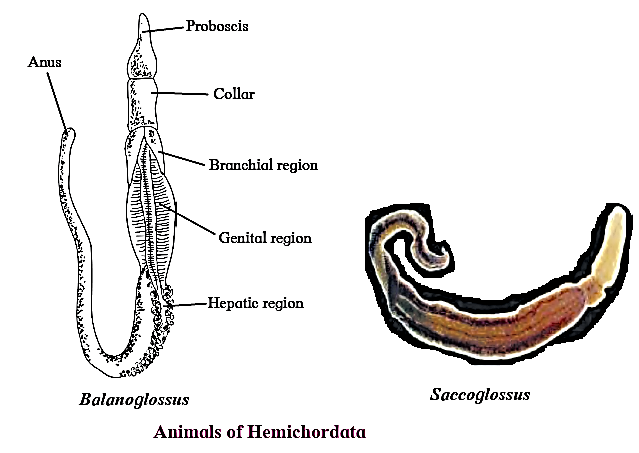
[collapse]
Q. Hemichordata is the connecting link between Non-Chordata and Chordata. Give reasons.
Answer :
- Hemichordata was earlier considered as sub phylum of Chordata because the buccal diverticulum was considered as notochord. It is now placed as a separate phylum under Non-Chordata.
- ii. It possesses certain characteristics of both Chordates and Non-chordates.
- iii. Absence of notochord and worm-like body are the Non-chordate like characteristics seen in Hemichordata.
- iv. Presence of nerve chord, pharyngeal gill slits are some of the Chordate-like characters seen in Hemichordata.
- Hence, Hemichordata is considered as a connecting link between Non-chordata and Chordata.
[collapse]
Difference between Chordates and Non-chordates :
Difference between Chordates and Non-chordates :
| Non-Chordata |
Chordata |
| Notochord is absent. |
Notochord present at least in the early embryonic life. |
| Nerve cord is ventral, paired and ganglionated. |
Nerve cord is single, dorsal and non-ganglionated. |
| The heart, if present is dorsal, |
The heart is ventral in position, |
| Pharyngeal gill slits are absent. |
Pharyngeal gill slits are present at least in embryonic stage. |
| Post-anal tail is absent. |
Post anal tail is present at least in embryonic stage. |
[collapse]
Phylum Chordata :
Characteristics of Chordates :
- Presence of cartilagenous notochord at least in early embryonic life,
- Presence of gill slits in the pharyngeal (neck) region,
- Presence of hollow, dorsal nerve cord running throughout the length of body and ventral heart.
Phylum Chordata is divided into three subphyla :
- Urochordata, Cephalochordata and Vertebrata.
- Urochordata and Cephalochordata are collectively called Protochordates.
Subphylum Urochordata : These are also called as tunicates or ascidians.
Features of Urochrodata :
Features of Urochordata :
- Habitat: They are exclusively marine.
- Body covering: Sot body is covered by ‘test’ or ‘tunic’ which is made up of tunicine.
- Notochord: Notochord is present only in the tail of the larva and is lost during metamorphosis. Hence, the name Urochordata.
- Respiration: Pharynx with many gill slits for respiration.
- Circulation: Closed circulatory system is present.
- Reproduction: Development is indirect.
- Examples : Herdmania, Salpa, Doliolum, Ascidias
[collapse]
Subphylum : Cephalochordata : Cephalochordates are also known as lancelets and are small fish-like animals that rarely exceed 5 cm in length
- Lancelets are exclusively marine and live partly buried in soft marine sediments.
- Notochord extends throughout entire length of the body and persists throughout life.
- Myotomes (muscle blocks) are present.
- Post anal tail is present.
- Circulatory system is closed type. Blood lacks pigment.
- Example : Branchiostoma

Subphylum : Vertebrata
- In these chordates, notochord is replaced by cartilaginous or bony vertebral column.
- It is divided into two divisions – Agnathostomata (no jaws) and Gnathostomata (jaws present).
Division Agnathostomata
- This division includes the lowest or most primitive vertebrates without jaws.
- Include only one class of living vertebrates - the Cyclostomata.
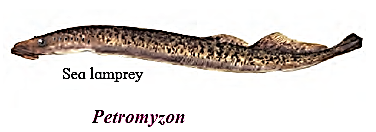
Cyclostomes :
Features of Cyclostomata :
Features of class Cyclostomata: (Cyclos : Circular, Stoma - mouth)
- Cyclostomes are jawless and eel-like animals.
- Skin is soft, smooth containing unicellular mucus glands, but no scales.
- Median fins are present but paired fins are absent.
- Ectoparasites.
- They have sucking and circular mouth without jaws.
- Cranium and vertebral column made up of cartilage.
- Digestive system lacks stomach.
- Respiration occurs by 6 to 15 pairs of gills slits.
- Gills slits are without operculum.
- Heart is two chambered with one auricle and one ventricle.
- Gonad is single, large and without gonoduct.
- Fertilization is external.
- They are anadromous i.e. migrate for spawning to fresh water from their marine habitat. After spawning, they die within few days.
- Larvae metamorphose and then migrate to ocean.
- e.g. Petromyzon (Lamprey), Myxine (Hagfish).
[collapse]
Division Gnathostomata : It is divided into two superclasses - Pisces (bear fins) and tetrapoda (bear four limbs).
Features of superclass Pisces :
Important features of superclass Pisces:
- Habitat: These are aquatic animals and are present in fresh, marine and brackish waters.
- Body temperature: Pisces are poikilothermic animals i.e., cold blooded animals, in which body temperature changes according to the change in the surrounding temperature.
- Sensory organs: They have lateral line system which shows the presence of rheoreceptors for the detection of water current.
- Locomotion: Locomotion is by body muscles and fins. Caudal fin helps in steering wheel.
- Skeleton: Exoskeleton is made up of dermal scales. It is either bony or cartilaginous.
- Body shape: Body is streamlined and boat-shaped and helps to overcome resistance during swimming,
- Respiration: Respiration is by gills.
- Circulation: It shows single and closed circulation. Heart is two chambered and ventral in position. Heart of fishes is described as venous heart (presence of deoxygenated blood).
- Nervous system: They have a well-developed brain with large olfactory lobes.
- Reproduction: Sexes are separate. Most of the fishes are oviparous, however some are viviparous.
[collapse]
Class Chondrichthyes : (chondron : cartilage, ichthyes : fish)
Features of class Chondrichthyes :
Features of Chondrichthyes :
- Endoskeleton is made of cartilage.
- Exoskeleton is made of minute scales called placoid scales.
- Mouth is ventral in position.
- There is a single dorsal fin and two pairs of lateral fins (pectoral and pelvic).
- 5 — 7 pairs of gill slits without operculum are present.
- Caudal fin is heterocercal.
- Males have copulatory organs called claspers located between the pelvic fins.
- Air bladder is absent.
- Many of them are viviparous animals.
- Examples : Scolidon (dogfish), Pristis (sawfish), Electric ray, Common skate, Hammer headed shark, Carcharodon (Great white shark), Trygon (Stingray), Anoxypristis.
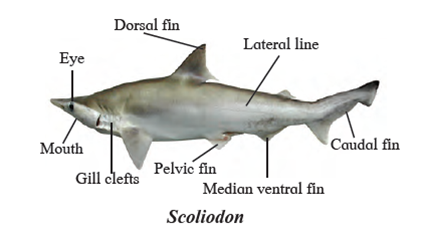
[collapse]
Class : Osteichthyes : (Osteon : bone , ichthyes : fish)
Features of class Osteichthyes :
Features of Osteichthyes :
- Endoskeleton is made of bones,
- Exoskeleton is made of large, flat and overlapping cycloid or ctenoid scales.
- Mouth is mostly terminal in position.
- Two dorsal fins are present.
- Four pairs of gills covered by operculum are present.
- Males lack claspers.
- Air bladder is present to maintain buoyancy. Thus, these fishes do not need to swim constantly,
- They are oviparous animal,
- Examples: Exocoetus (Flying fish), Hippocampus (Sea horse), Labeo rohita, Pomphret (Rohu), Catla (Katla), Clarius (Magur), Pterophyllum (Angle fish),_Bombay duck, Lung fishes (Protopterus, Lepidosiren), Aquarium fishes like Betta (Fighting fish)
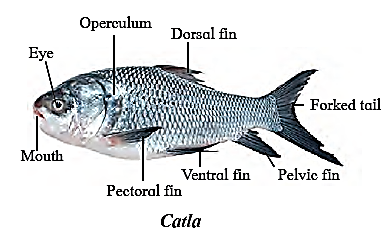
[collapse]
Q. Why Piscian heart is called a venous heart?
Answer :
Ans. Heart of Pisces receives blood only from veins and thus always shows presence of deoxygenated blood which it pumps directly to the gills for oxygenation. Thus, the heart of Pisces is called a venous heart.
[collapse]
Superclass Tetrapods :
Tetrapods are group of vertebrates that includes amphibians, reptiles, birds and mammals. It include animals that bear two pairs of appendages (with some exceptions e.g. Snakes are limbless, etc.)
Amphibians : (Amphi : both, bias : life)
Features of class Amphibians :
- These animals live on land as well as in water (fresh water only).
- Amphibians are poikilothermic animals.
- Body is differentiated into head, and trunk. Neck and tail are absent in many adults with few exceptions.
- Two pairs of limbs arise from the pectoral and pelvic girdles respectively, which help in locomotion.
- Skin is moist and glandular with mucous glands.
- Exoskeleton is absent.
- Eyelids are present. Tympanum represents the ear.
- Excretory products, digestive products and gametes are released through the common chamber cloaca.
- Circulatory system is of closed type. Heart is three chambered and ventral. RBCs are biconvex and nucleated.
- Respiration is by skin, lungs and bucco-pharynx.
- Nervous system is well developed.
- Sexes are separate. Amphibians are oviparous. Fertilization is external and development is indirect through aquatic larval stage.
- They exhibit metamorphosis.
- Examples : Rana (Frog), Bufo (Toad), Salamandra (Salamander), Ichthyophis (Limbless amphibian), Hyla (Tree frog).
[collapse]
Q. Amphibians do not have exoskeleton. Give reason.
Answer :
Ans. Amphibians can live on land as well as in water. They breathe through their moist skin under water and if their skin would have been covered with scales (exoskeleton) they would not be able to breathe.
Although the exoskeleton is required for protection from the external environment and it is absent in amphibians, they have well developed endoskeleton which comprises of bones and cartilage. It provides structural support and protection to the internal organs.
[collapse]
Class Reptilia : (Repere : to creep or to crawl)
Features of class Reptilia :
Salient features of Reptilia:
- Habitat: They are crawling animals. They are the first true terrestrial vertebrates. Few may be aquatic or semi-aquatic and are also found in marshy areas.
- Locomotion: Locomotion occurs by limbs in most animals. The limbs are pentadactyl with clawed digits, which help the animal to walk, creep or crawl. Snakes are limbless and crawl on their belly.
- Body temperature: They are called poikilotherms as their body temperature changes according to the change in surrounding temperature.
- Exoskeleton: Skin is dry, non-glandular and covered by an exoskeleton of epidermal scales or scutes, shields or plates. Lizards and snake shed their skin periodically.
- Ear: Tympanum is present
- Circulatory system: It has two complete auricles but the ventricles are incompletely partitioned. Therefore, the heart of reptiles is not perfectly four chambered (except in crocodile the heart is four chambered).
- Nervous system: The brain is well developed. The olfactory lobes and cerebellum are better developed as compared to amphibians.
- Reproduction: Sexes are separate and exhibit prominent sexual dimorphism. Fertilization is internal and the animals are oviparous (exception - viper, it is viviparous). They show little parental care.
- Examples : Naja naja (Cobra), Hemidactylus (Wall lizard), Chelonia ( Turtle), Crocodilus (Crocodile), Testudo (Tortoise), Chameleon (Tree lizard), Bangarus (Krait), Vipera (viper).
[collapse]
Class Aves : (Avis : bird)
Features of class Aves :
The salient features of class Aves:
- Habitat: These animals are aerial in habitat. v
- Locomotion: Forelimbs are modified into wings for flying. Hind limbs are used for walking, clasping tree branches and running. Aquatic birds have webbed toes. This helps in swimming. e.g. Duck.
- Body division: Body is differentiated into head, neck, trunk and tail.
- Body shape: Body is streamlined (boat shaped) to reduce resistance during flight.
- Body temperature: These are warn - blooded animals (homeotherms) i.e., keep the body temperature constant irrespective of fluctuations in environmental temperature.
- Exoskeleton: Exoskeleton is made up of feathers. Scales are present on hind-limbs. Skin is thin dry and non-glandular except oil gland at the base of tail (uropygial gland).
- Endoskeleton: Bones are hollow (pneumatic) with air cavities to reduce body weight.
- Digestion: Jaws are modified into beaks. Teeth are absent. Special structures such as crop and gizzard are present.
- Circulatory system: They show double circulation. Blood is red in colour due to presence of biconvex and nucleated RBCs. Heart is perfectly four chambered, with two auricles and two ventricles.
- Respiration: Respiration occurs by lungs. Presence of air sacs increases the buoyancy.
- Nervous system: Brain is enlarged with a well-developed cerebellum for equilibrium.
- Reproduction: Sexes are separate and the animals exhibit prominent sexual dimorphism. The female show, presence of only left ovary and left oviduct. This helps to reduce body weight during flying. Fertilization is internal. Avians are oviparous. Parental care is very well developed.
- Examples: Columba (Pigeon), Psittacula (Parrot), Flight less birds like Struthio (ostrich), Kiwi, Aptenodytes (Penguin), Corvus (crow), Neophron (Vulture), Passer (sparrow). Etc.
[collapse]
Adaptations in Aves for flying :
- In birds, the forelimbs are modified into wings for flying.
- They possess stream-lined body to reduce resistance during flight.
- Bones are hollow or pneumatic to reduce body weight.
- In order to reduce body Weight, females possess only left ovary and oviduct
- Body is covered by feathers to facilitate flying.
Class Mammalia : (mammae: breasts, nipple)
Features of class Mammalia :
Features of class Mammalia:
- Special feature: Presence of mammary glands (milk producing glands) for the nourishment of young ones. Mammary glands are modified sweat glands.
- Habitat: Mammals are omnipresent (present everywhere). These are mostly terrestrial, some are aquatic and few are aerial and arboreal (living on trees).
- Locomotion: Limbs are the organs of locomotion and are modified for walking, climbing, burrowing, swimming, etc.
- Body division: Body is differentiated into head, neck, trunk and tail. They have external ear (pinna).
- Body temperature: Mammals are homeotherms or warm-blooded animals. i.e., keep the body temperature constant irrespective of fluctuations in environmental temperature.
- Exoskeleton: It is in the form of hair, fur, nails, hooves, horns, etc.
- Skin: Skin is glandular and has sweat glands and sebaceous (oil) glands.
- Mouth cavity: Mammals show heterodont dentition (various types of teeth like incisors, canines, premolars and molars).
- Circulation: Heart is ventral in position, four chambered with two auricles and two ventricles. RBCs are biconcave and enucleated (except camel). Blood is red in colour. ‘Respiration: Respiration takes place by lungs.
- Nervous system: Brain is highly developed. Cerebrum shows a transverse band called corpus callosum.
- Reproduction and development: Only few mammals are oviparous. e.g. Duck billed platypus. Some have pouches for development of immature young ones. These are called marsupials. e.g. Kangaroo. Most of the mammals are placental and viviparous.
- Examples: Bat, Rattus (Rat), Macaca (Monkey), Camelus (Camel), Whale, Human being, Cannis (dog), Felis (Cat), Elephas (Elephant), Equus (Horse), Pteropus (flying fox). Oviparous - Ornithorhynchus (Platypus). Viviparous - Macropus (Kangaroo).
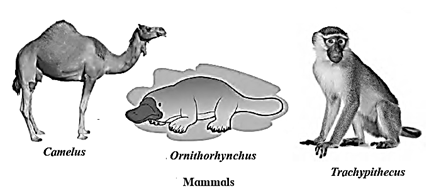
[collapse]



















These app is not showing 10th chapter animal tissue of class 11
Not ready yet, will be available soon.